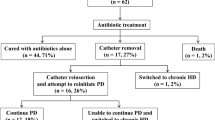Abstract
Children undergoing long-term peritoneal dialysis are at risk for membrane injury, necessitating conversion to hemodialysis. We analyzed the incidence and risk factors for membrane failure (inadequate ultrafiltration with or without peritoneal adhesions and decreased peritoneal surface area) in 68 children maintained with peritoneal dialysis for more than 3 months at our institution. The overall incidence of membrane failure was 16.2% (11/68). Kaplan-Meier estimates of peritoneal membrane survival were 88% at 24 months, 72% at 36 months, 65% at 48 months, and 52% at 60 months. Logistic regression analysis demonstrated that the risk of membrane failure increased with the number of episodes of peritonitis (odds ratio 1.61). The rate of peritonitis was 1 per 7.02 patient months in children who developed membrane failure compared with 1 per 9.18 patient months in children without membrane failures but the rate of peritonitis was not predictive of membrane failure (P=0.09). Multiple logistic regression analysis demonstrated that peritonitis caused byPseudomonas aeruginosa or alpha streptococcal organisms were independent predictors of membrane failure. We conclude that peritoneal membrane survival declines substantially with time on peritoneal dialysis and that membrane failure is associated with peritonitis, particularly peritonitis caused byPseudomonas aeruginosa and alpha streptococcal organisms. The mechanism(s) of membrane injury are unknown but may be related to the inflammatory response initiated during peritonitis.
Similar content being viewed by others
References
Fine RN (1982) Peritoneal dialysis update. J Pediatr 100:1–7
Lilien T von, Salusky IB, Boechat I, Ettinger RB, Fine RN (1987) Five years experience with continuous ambulatory peritoneal dialysis in children. J Pediatr 111:513–518
Warady BA, Kriley M, Lovell H, Farrell SE, Hellerstein S (1988) Growth and development of infants with end-stage renal disease receiving long-term peritoneal dialysis. J Pediatr 112:714–719
Maher JF (1990) Physiology of the peritoneum. Implications for peritoneal dialysis. Med Clin North Am 74:985–996
Rubin J, Nolph K, Arfania D, Brown P, Prowant B (1979) Follow-up of peritoneal clearances in patients undergoing continuous ambulatory peritoneal dialysis. Kidney Int 16:619–623
Lilien T von, Salusky IB, Little RJA, Alliapolous JC, Leichter HE, Hall TL, Fine RN (1987) Peritoneal kinetics in children undergoing continuous ambulatory/cycling peritoneal dialysis. Am J Kidney Dis 10:431–438
Verger C, Luger A, Moore HL, Nolph KD (1983) Acute changes in peritoneal morphology and transport properties with infectious peritonitis and mechanical injury. Kidney Int 23:823–831
Rubin J, McFarland S, Hellems EW, Bower JD (1981) Peritoneal dialysis during peritonitis. Kidney Int 19:460–464
Heimburger O, Waniewski J, Werynski A, Tranaeus A, Lindholm B (1990) Peritoneal transport in CAPD patients with permanent loss of ultrafiltration capacity. Kidney Int 38:495–506
Slingeneyer A, Caunaud B, Mion C (1983) Permanent loss of ultrafiltration capacity of the peritoneum in long-term peritoneal dialysis: an epidemiological study. Nephron 33:133–138
Wideroe TE, Smeby LC, Mjaland S, Dahl K, Berg KJ, Aas TW (1984) Long-term changes in transperitoneal water transport during continuous ambulatory peritoneal dialysis. Nephron 38:238–247
Krediet RT, Boeschoten EW, Zuyderhoudt FMJ, Arisz L (1987) The relationship between peritoneal glucose absorption and body fluid loss by ultrafiltration during continuous ambulatory peritoneal dialysis. Clin Nephrol 27:51–55
Mactier RA, Khanna R, Twardowski Z, Moore H, Nolph KD (1987) Contribution of lymphatic absorption to loss of ultrafiltration and solute clearances in continuous ambulatory peritoneal dialysis. J Clin Invest 80:1311–1316
Mactier RA, Khanna R, Twardowski ZJ, Nolph KD (1987) Ultrafiltration failure in continuous ambulatory peritoneal dialysis due to excessive peritoneal cavity lymphatic absorption. Am J Kidney Dis 10:461–466
Verger C, Brunschvicg O, LeCharpentier Y, Lavergne A, Vantelon J (1981) Structural and ultrastructural peritoneal membrane changes and permeability alterations during continuous ambulatory peritoneal dialysis. Proc Eur Dial Transplant Assoc 18:199–205
Niaudet P, Berard E, Revillon Y, Lothon M, Broyer M (1987) Sclerosing encapsulating peritonitis in children. Contrib Nephrol 57: 230–238
Gandhi VC, Humayun HM, Ing TS, Daugirdas JT, Jablokow VR, Iwatsuki S, Geis WP, Hano JE (1980) Sclerotic thickening of the peritoneal membrane in maintenance peritoneal dialysis patients. Arch Intern Med 140:1201–1203
Vas SI (1983) Microbiologic aspects of chronic ambulatory peritoneal dialysis. Kidney Int 23:83–92
Juergensen PH, Finkelstein FO, Brennan R, Santacroce S, Ahern MJ (1988)Pseudomonas peritonitis associated with continuous ambulatory peritoneal dialysis: a six year study. Am J Kidney Dis 11: 413–417
Rubin J, Guillermo AH, Collins D (1991) An autopsy study of the peritoneal cavity from patients on continuous ambulatory peritoneal dialysis. Am J Kidney Dis 18:97–102
DiPaolo N, Sacchi G, DeMia M, Gaggiotti E, Capotondo L, Rossi P, Bernini M, Pucci AM, Ibba L, Sabatelli P, Alessandrini C (1986) Morphology of the peritoneal membrane during continuous ambulatory peritoneal dialysis. Nephron 44:204–211
Fantone JC, Ward PA (1982) Role of oxygen-derived free radicals and metabolites in leukocyte-dependent inflammatory reactions. Am J Pathol 107:397–418
Weiss SJ (1989) Tissue destruction by neutrophils. N Engl J Med 320:365–376
Topley N, Alobaidi HMM, Davies M, Coles GA, Williams JD, Lloyd D (1988) The effect of dialysate on peritoneal phagocyte oxidative metabolism. Kidney Int 34:404–411
DiPaolo N, Sacchi G (1989) Peritoneal vascular changes in continuous ambulatory peritoneal dialysis (CAPD). An in vivo model for the study of diabetic microangiopathy. Perit Dial Int 9:41–45
Author information
Authors and Affiliations
Rights and permissions
About this article
Cite this article
Andreoli, S.P., Langefeld, C.D., Stadler, S. et al. Risks of peritoneal membrane failure in children undergoing long-term peritoneal dialysis. Pediatr Nephrol 7, 543–547 (1993). https://doi.org/10.1007/BF00852541
Received:
Revised:
Accepted:
Issue Date:
DOI: https://doi.org/10.1007/BF00852541




